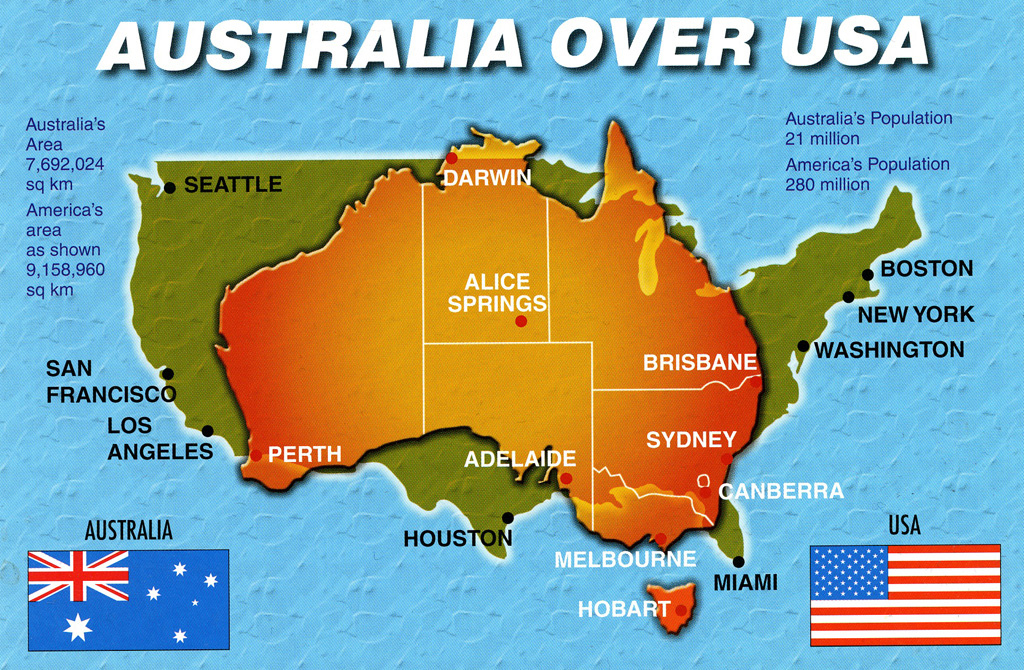When comparing the size of Australia vs USA, it's essential to recognize the vast differences in land area, population density, and geographical features that define these two countries. Both nations boast unique landscapes and cultural identities, but their sizes tell a fascinating story about their geographical significance. The differences in size also influence not only environmental conditions but also economic and social aspects of life in each country.
Australia, often referred to as the "island continent," is the sixth-largest country in the world, covering approximately 7.692 million square kilometers. In contrast, the United States ranks third in size, encompassing around 9.834 million square kilometers. This difference in area is significant and has implications for everything from biodiversity to urban planning. Understanding these figures provides insight into how each nation interacts with its environment and manages its resources.
As we delve deeper into the topic of the size of Australia vs USA, we will explore not only the numerical differences but also how these sizes translate into practical realities for the inhabitants of each country. From the vast deserts of Australia to the bustling cities of America, the geographical size influences the lifestyle, culture, and economy of both nations. Let’s uncover the fascinating contrasts between these two giants of the Southern and Northern Hemispheres.
What is the Total Area of Australia and the USA?
The total area of a country is a fundamental measure that provides insight into its geographical scale. Here is a breakdown of the total land areas:
- Australia: 7.692 million square kilometers
- United States: 9.834 million square kilometers
How Does the Size of Australia Compare to the USA?
To understand the size of Australia vs USA in practical terms, it’s useful to visualize the scale. For instance, Australia is approximately 78% the size of the USA. This difference might not seem enormous at first glance, but it becomes more apparent when considering the populations and land utilizations of each country.
What are the Population Densities in Australia and the USA?
Population density plays a crucial role in how each country functions and develops. The population density can be calculated by dividing the total population by the total land area. Here’s a comparison:
- Australia: Approximately 3.3 people per square kilometer
- United States: Approximately 36 people per square kilometer
This stark contrast in population densities highlights how vast areas of Australia remain sparsely populated, while the USA has a much higher concentration of people in urban areas.
What Are the Major Geographical Features of Australia and the USA?
The geographical features of a country can significantly influence its culture, economy, and biodiversity. Here are some of the major features of each country:
- Australia:
- Great Barrier Reef
- Outback desert regions
- Unique wildlife
- United States:
- Rocky Mountains
- Great Plains
- Numerous national parks, including Yellowstone and Yosemite
How Does Climate Differ Between Australia and the USA?
Climate is another area where the differences in size and geographical features come into play. Australia generally has a more arid climate, particularly in the interior regions, while the USA has a broader range of climates, from tropical in Florida to arctic in Alaska. These climatic differences influence everything from agriculture to tourism in both countries.
What Are the Economic Implications of the Size of Australia vs USA?
The size of Australia vs USA has significant economic implications. The larger land area of the USA allows for a diverse range of industries, from agriculture to technology, contributing to its status as one of the largest economies in the world. In contrast, Australia's economy is heavily reliant on mining and agriculture, with vast areas dedicated to these industries. This difference in economic focus is partly due to the varying sizes and resources available in each country.
What Are the Urbanization Trends in Australia and the USA?
Urbanization trends are influenced by the size and population density of a country. In the USA, major cities like New York, Los Angeles, and Chicago have sprawling metropolitan areas, which are home to millions. In contrast, Australia’s largest city, Sydney, while significant, has a smaller metropolitan area compared to major American cities. The size of Australia vs USA is reflected in these urbanization patterns, with the USA exhibiting a more pronounced trend toward large urban centers.
What Are the Environmental Challenges Faced by Australia and the USA?
Both countries face unique environmental challenges that stem from their geographical sizes and features:
- Australia:
- Climate change impacts on the Great Barrier Reef
- Invasive species affecting native wildlife
- Water scarcity in arid regions
- United States:
- Wildfires in the West
- Hurricanes in the South
- Pollution in urban areas
What Is the Future of Australia and the USA in Terms of Land Use and Conservation?
As both countries move forward, land use and conservation will become increasingly important. The size of Australia vs USA will continue to shape policies regarding environmental protection and sustainable development. In Australia, efforts are being made to protect unique ecosystems, while in the USA, conservation initiatives focus on preserving national parks and addressing climate change.
In conclusion, the size of Australia vs USA offers a fascinating study in contrasts. From geographical features to population densities and economic implications, understanding these differences provides valuable insights into how each nation navigates its unique challenges and opportunities. As we continue to explore and appreciate the vastness of these countries, it is crucial to consider how geography shapes not just landscapes but lives and livelihoods.



